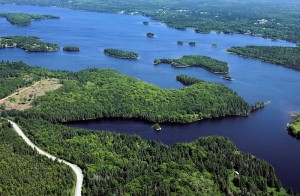Do you own any islands in Catalone Lake, Cape Breton County? If so, you’ve got until June 26 2015 to let the Department of Natural Resources know before it claims them for the Crown
A series of small islands in Cape Breton have been earmarked by Nova Scotia’s Department of Natural Resources as a possible protected area for rare migratory and nesting birds. There’s only one problem, however – no-one knows to whom the islands belong.
No Clear Ownership Titles
Located near Main-a-Dieu, the six Catalone Lake islands – which together comprise of less than a hectare – currently fall under the Provinces “owner unknown” program, meaning that the land has no clear ownership title.
“If Property Online [the Province’s Land Registration Database]shows it as owner unknown — which means they have no record, no deeds, no wills, no documents to back up who owns it — then lands revert back to the Crown,” said Jody Nelson, from the Natural Resources Department.
Property owners now have just 18-months to stake their claim to the land. If no-one comes forward during this so-called vesting period, the six islands will automatically revert back to the Province, officially becoming Crown land.
Eighteen Months to Stake a Claim
As per local protocol, the provincial Land Services Branch has already reached out to the local press for assistance, but has thus far received no responses to its initial six-week long advertisement campaigns. It intends to run one final news advertisement next week.
“If anybody has any deeds or any ownership or claim to the lands, they are to notify the Department of Natural Resources and after that 18 month period, if we don’t hear from anybody the lands will be considered Crown land,” DNR biologist Glen Parsons told CBC Canada.
The land will then be evaluated to establish whether there is potential for either management or a stewardship program. Owing to their lack of predators and human disturbances, however, islands usually tend to be set aside for wildlife conservation or habitat protection.
“Islands are great locations for wildlife. They’re relatively undisturbed and so for migratory birds or as bird nesting sites, they provide valuable habitat. Indeed, there are certain species of birds,” the biologist explained, “that nest exclusively on islands throughout Nova Scotia.”
Potential Protected Area
If the islands do eventually become Crown land, current plans suggest that they will be protected in accordance with the North American Waterfowl Program as part of the Eastern Habitat Joint Venture – a conservation program which is dedicated to conserving habitat for migratory birds and which stretches from Ontario to Newfoundland.
Explaining how the uninhabited islands could provide an important resource, both now and in the future, Parsons predicted that – if successful – the six islands could ultimately form an important home and breeding ground to nesting eagles, herons, songbirds and more.
Read More:
- Nova Scotian Conservation Group Adds New Island to Protected Area (April 2015)
http://www.privateislandnews.com/canada-nova-scotian-conservation-group-adds-new-island-to-protected-area/ - Nova Scotia Nature Trust Reveals Mystery Millionaire Donor (November 2014)
http://www.privateislandnews.com/2014-11-10-canada-nova-scotia-nature-trust-reveals-mystery-millionaire-donor/ - Canada Purchases 100 East-Coast Private Islands for Nature Protection (July 2014)
http://www.privateislandnews.com/2014-jul-16-canada-purchases-100-east-coast-private-islands-for-nature-protection/



